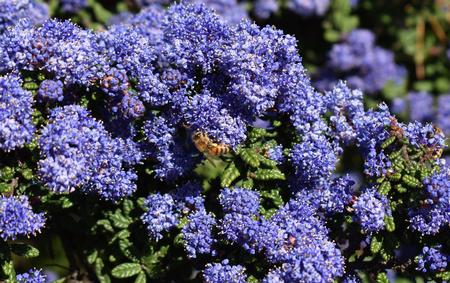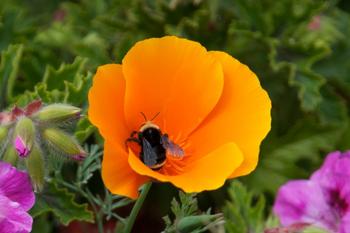Winter 2024
Winter Blooms for Garden Pollinators
by Laurinda Ochoa

During our cold and wet winter season, many native birds and pollinators rely on plants to provide both food and shelter. Some easy-to-grow winter-blooming native plants that provide pollen, nectar, and shelter are Manzanita, Ceanothus, Toyon, and Silktassel. There are also California wildflowers that bloom in the late winter and early spring when they have become established in the fall and early winter months.
Manzanitas, ‘Arctostaphylos manzanita’

There are over 90 varieties of Manzanitas, or ‘Arctostaphylos’. These California natives range in size from ground covers to large shrubs and even small trees. They are important early nectar sources for our native bees and hummingbirds.
Manzanita’s small, reddish-brown fruits are also an important food source for both birds and mammals during the fall and early winter months.
‘Ceanothus’

Like Manzanitas, Ceanothus flower in the late winter through early spring. Flowering time depends on rainfall and local temperatures. Their fragrant blossoms provide pollen, nectar, and, eventually, small, berry-like fruits for pollinators and birds.
With over 100 varieties, Ceanothus can be low ground covers, mid-sized shrubs, or small, multi-branched trees. And, with their dense foliage and flowers, Ceanothus are an important habitat, providing a vital source of food, shelter, and nesting sites for Bay Area birds.
Toyon
Toyon, or ‘Heteromeles arbutifolia’, is a beautiful evergreen perennial shrub native to our area. Also known as Christmas Holly and Christmas Berry, this common shrub typically grows 8–10 feet tall and bears small, bright red fruits that mature in the fall and winter. These berries are favorites of many of our bird species, including robins, finches, cedar waxwings, and mockingbirds.
Unlike Pyracantha, another common but non-native shrub that has seasonal red berries that attract birds, Toyon does not have spines.
Toyon is a beautiful habitat plant that provides seasonal color for humans and winter food and shelter for birds and small mammals.
Silktassel

The catkins on male Silktassel plants are long, showy gray-green pendant flower clusters, reaching up to 12 inches in length. Female catkins are shorter and silver-gray.
Silktassel is an interesting shrub that provides food and habitat for native pollinators and unique winter blooms for our gardens.
California Wildflowers

Perhaps the best-known of these early bloomers is the poppy. California Poppy, ‘Eschscholzia california’, is a short-lived perennial that can provide both pollen and nectar during our late winter and early spring months. One of the earliest wildflower bloomers, poppies sown in the fall and those plants that are entering their second bloom season after going dormant in the summer heat, begin to produce flower buds with winter rains.
Other wildflowers that can bloom in the late winter under the right conditions include Baby Blue Eyes (‘Nemophila menziesii’); Shooting Star (‘Primula’); and California Buttercup (‘Ranunculus californicus’). These late-winter and early-spring bloomers need to become established during the preceding fall and early winter months.
Our California native bees, butterflies, birds, and other insect pollinators have coevolved in our summer-dry winter-wet environment with native plants, trees, grasses, and other living organisms. By observing our natural habitat, you might be able to draw inspiration and bring some of these more adaptable plants and trees into our garden landscapes.
One of the bright spots in the winter months can be watching our gardens provide the blooms and shelter needed by our native pollinators.
